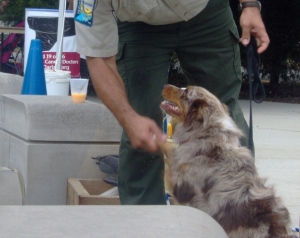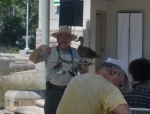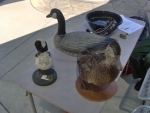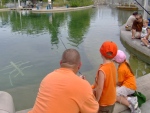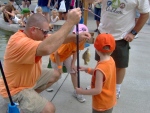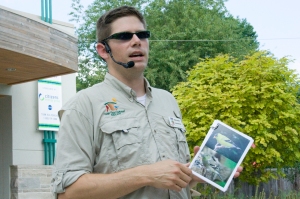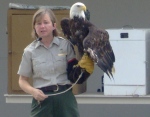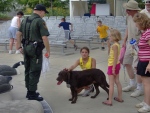To start, I’d like to replay a recent quibble that I had with my fiance…SCENE!
Fiance: “You are not going to have a bat farm.”
Me: “I don’t want a bat farm. I want to rehab them.”
Fiance: “You aren’t going to rehab bats. You can’t even give them the right habitat: they live in caves.”
Me: “Not all species of bats live in caves. Many live in trees. And besides, if we don’t take care of our bats, there may not be any left in the US in 20 years.”
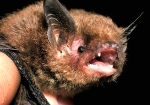
A common bat, the Indiana Bat.
Oh yes. That conversation really happened. But let’s back up a bit. I want to rehab bats. Ever since I saw an episode of “Dirty Jobs” 3 years ago, I’ve wanted to rehab them. They get such a bum rap. Not all are ugly (although some don’t exactly win the cute contest), they do not drink our blood (but there is a species of bat called the vampire bat, but more on him in a moment), they don’t ALL carry rabies, and they don’t fly in our hair. These are actually incredibly beneficial little mammals (yes, MAMMALS) that deserve our respect and our protection. So many evil myths surround the little guys that I wasn’t at all surprised to hear them spouted off during the “Indiana Bats: Myths and Reality” at the State Fair.
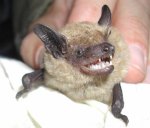
The largest Indiana bat, the Big Brown bat.
Myth #1: Bats fly in your hair.
Okay, let me clear this one up…they don’t fly in your hair. Bats have a wonderful adaptation called echolocation. This means that they send out high-frequency sound waves, which bounce off of whatever is in front of them, helping them get a mental picture of what’s going on. Say you use a wonderful-smelling shampoo or perfume and go outside at dusk. You end up surrounded by pesky insects, don’t you? You smell good to them! A little bat looking for his dinner locks on to that bug buzzing in your ear. You see his little silhouette coming at you, unaware that he is trying to rid you of your insect annoyance. You try to jump out of the way, but instead jump right into the bat’s flight path. And he ends up in your hair. Guess what? You’re at fault for this collision. He would have never touched you had you held still. He knew exactly where you were and exactly where that bug was. But because you freaked, you changed his flight path and he wasn’t able to abort the mission in time. So there you go. Bats don’t get in your hair. You get in their flight path.
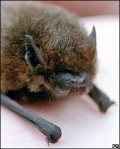
Indiana's smallest bat, the Pipistrelle Bat.
Myth #2: Bats drink your blood.
Once again…negative. There are some 950 species of bats in the world, only 3 actually feed on blood, and all 3 are found in Latin America. There are no bat species in the United States that feed on the blood of other animals. The bat species in the US feed on insects, fruits, and flowers. They do not see us a food source. Ever. And to clear this up even further, those 3 species do not feed on human blood. They often feed on larger mammals, such as cows and other livestock. And they certainly do not drain these animals dry. In fact, most of the time the animals don’t even notice what’s going on.
Myth #3: All bats are rabid.
Wrong again. In fact, only 0.5% of bats are found to carry rabies. That’s one-half of a percent! Your dog is more likely to carry the disease, as dogs account for 99% of all rabies cases. Even if a bat did have rabies, it’s unlikely that it’d survive longer than 48 hours with the disease, as it takes its toll quickly on the minuscule mammals.
So now that I’ve cleared up the more common, completely untrue myths about bats, let’s hear some reality about them:
Did you know that for every 1 acre of cornfield (just as an example), a colony as small as 10 individuals can eat over 1 billion bugs in a season? 1 BILLION BUGS!
Did you know that not all bat species live in caves? Some bat colonies are tree-dwellers, and some will even establish themselves in man-made bat houses.
Did you know that fruit-eating bats account for 98% of all rainforest regrowth?
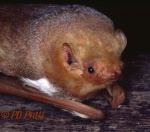
Another common bat, the Red Bat.
But through all the good, the bats in the US are in big trouble. Bat colonies along the east coast are being infected by a fungus dubbed “White Nose Disease”. The fungus itself doesn’t kill the bats, but it wakes them up out of their hibernation, causing them to starve to death because of a lack of available food sources in the winter. It’s currently mainly affecting cave-dwelling species, as the fungus is hitchhiking on human spelunkers and being transferred from cave to cave. Indiana (among other states) took a very proactive approach and closed down the state’s caves, but that certainly doesn’t prevent a colony from leaving and moving to a different cave, thus contracting the fungus. The fungus is so aggressive and becoming so widespread that, if we do not get it under control, the ENTIRE bat population in the United States could be gone in 20 years.
To find out more on how you can help bats, visit Bat World Sanctuary at http://www.batworld.org.
-Jess




